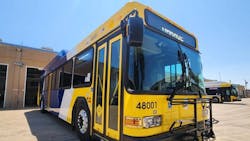DART welcomes the first new buses of its new fleet
Dallas Area Rapid Transit (DART) received two buses of its new 476-bus fleet, part of a modernization program to improve the entire transit system for its riders.
DART Transform is focused on upgrades throughout its system, including vehicles, stations, passenger facilities, operating facilities and a unified signaling system. This is part of a broader goal for the agency, DART Point B Strategic Plan, designed to deliver fast, convenient and easy public transit for its ridership.
“We’ve made a strategic commitment to improving our entire transit network with DART Transform and the new buses will be the first major component that every rider will get to experience,” said DART President and CEO Nadine S. Lee. “We can’t wait to see the positive impact these new vehicles will have on our customers as they travel to their next destination with DART.”
Buses to pick up passengers later this fall
The delivery of the first two buses doesn’t mean passengers will see them in service right away though. Before the full-scale production begins later in October, these first deliveries allow for DART’s maintenance and operations teams to test and inspect the new stock. Like its current offerings, the new GILLIG buses will also operate on compressed natural gas (CNG).
DART received $103 million in the form of competitive grant from the FTA’s Low or No Emission Grant Program to aid in the purchase of these new buses. The grant covers nearly one third of the transaction cost, with DART also receiving a bulk purchasing discount in the amount of $15 million for buying 476 vehicles in one mass order.
To align with its ridership capacity needs, DART has made a purchase order for 76 30-foot buses and 400 40-foot buses. Once production of the order ramps up later this month, DART will begin to receive 20-30 of the new vehicles per month and will begin service with the new fleet in mid- to late-November.
Riders can expect some upgrades aboard the new stock, like vinyl seating, tinted windows, better bike racks and passenger information displays that will transmit ride info in both English and Spanish.
Aging fleet nearing the end of its useful life
DART is making the move to upgrade its fleet as it reaches the end of its useful life. According to FTA guidance, that occurs when a heavy-duty transit vehicle reaches 12-14 years in service or 500,000 miles on the road. DART’s new fleet will begin to replace its fleet as it broaches the 500,000-mile or useful lifespan mark. The agency is making the move as repair and maintenance events increase in frequency, severity and logistical difficulty.
